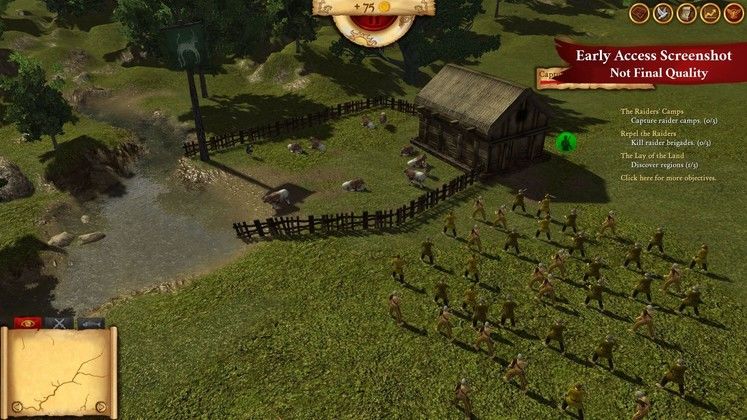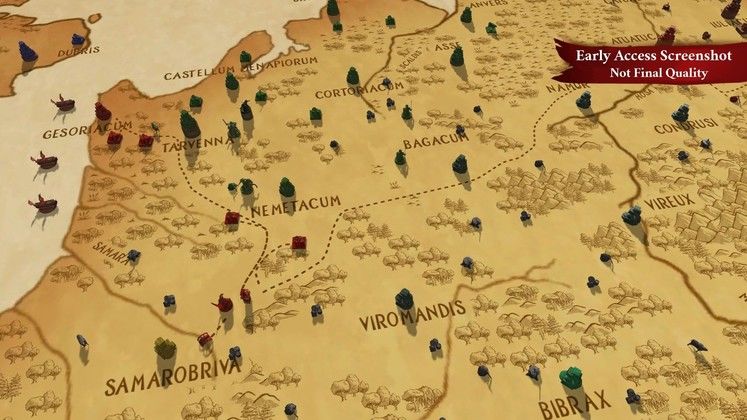Unlike Rome II's clumsy transitions between tactical and strategic maps, everything in Hegemony Rome is seamlessly controlled from one screen. You can zoom out for a traditional parchment map view of your holdings and troops, represented with chess-like pieces, or drag the camera right down to the ground to take direct control of skirmishes and battles. Spot some Gallic tribesman lingering on the border of your province? Zoom straight down to the ground and organise your defence. Supply lines getting cut? Flick back up and get an instant visual of your logistical situation. It's the Hegemony series' biggest and best unique feature, and Rome features the smoothest incarnation of it yet.
 |
| It's far from the cutting edge of computer graphics, but Hegemony Rome's visuals have a simple charm |
Logistical elements are typically pretty tedious affairs in most strategy games, but in Hegemony it's less painful than I expected to keep your troops fed. At least, it is in the first two campaigns I got to try. Basically it's as simple as clicking one settlement, then right-clicking the necessary goods-producing site; mines for stone, farms for produce and so on. Forts and structures need to be built or captured in between your major settlements in order to provide supplies to your armies marching long distances through unforgiving territory. Keeping troops and buildings well-stocked is essential when pushing forward into enemy zones. After all, an army marches on its stomach. Not literally, of course, that would be weird. The early missions I played were essentially little more than tutorials, but in more open campaigns and the sandbox mode this can presumably be exploited in order to unbalance your opponent. Torch a few of his farms and his ability to send large quantities of troops forwards will be compromised.
There's plenty of other construction options to consider. Roman troops can build bridges over rivers in order to access enemy zones, or construct military forts to safeguard certain areas from rampaging enemy scouts. Major cities are set in stone and can't be created, sourced as they are from historical records, but you can decide what to focus them on. One settlement might be your bread basket, while another might be the home of a garrison that provides levy troops. The construction and infrastructure of your holdings is simple enough that controlling a huge area shouldn't be too difficult, but still provides enough options to keep things interesting.
 |
| The campaign map is huge, with plenty of opportunities for tactical manoeuvring |
Battles are a little less inspiring, all told. Most combat scenarios, even the bigger-scale battles that Hegemony Rome adds to the series, end up as little more than extended bouts in which you rub units of infantry up against each other until one falls over. There are the expected tactical options; cavalry charges, flanking manoeuvres and the like, but it's very simplistic in execution. Often you'll have so little room to move that anything but a straight-up, manic charge is too cumbersome. The UI could use a little work too. Switching between unit formations and so on is unnecessarily clunky.
So while the basic unit by unit combat is workable enough, hopefully Longbow Games continue to work on making it a more unpredictable and varied affair during the game's Early Access period. I'm hopeful they can, because there are some little touches in there already that I really like. Capturing enemy units and forcing them to work in your settlements is especially satisfying, and there's also the option to get the daggers out and start executing if you don't have the time or inclination for a more subtle approach. With some tweaks and some polishing of the enemy AI, which rather too often favours the largely ineffectual 'run directly at the numerically superior enemy force' tactic, Longbow should be able to shore up these niggling issues.
Ultimately the combat system will never rival the complexity of something like the Total War series, but that's OK. That's not what it's trying to do. There are enough unique and inventive ideas in Hegemony Rome to make it stand out in its own right. That seamless tactical map is a joy to behold, a constantly changing summation of your military situation that offers welcome control. The greater infrastructure of a military campaign, with those larger issues of army supplies, fortifications and so on is what the game is really concerned with. The actual chopping and stabbing is just one small part of that. There's also obvious care and attention to detail throughout the game. I especially like the amount of care Longbow have put into historical detail. Each mini-campaign is based on a segment of Caesar's military campaigns in Gaul, with the objectives and details taken from the big man's own war journals. Click on a settlement and the text box fills you in on the historical significance of the location. When you play Hegemony Rome, you might actually learn something. Shocking, no?
 |
| Battles aren't that deep or involving at present, but as part of the overall picture they're functional |
Is this the finished article? No, certainly not. There's still plenty of work to be done. The UI could use refining and the combat needs polish. Graphical bugs and errors with unit-spawning triggers (some serious, like one early mission where scripted enemy units refused to enter the objective zone, forcing a save game reload) cropped up every now and then, and I experienced a couple of crashes to desktop. The usual Early Access conditions apply; be prepared for unfinished features and numerous quirks. That said, there's enough promise on show to ensure that I'll be keeping an eye on the game as it continues to grow and refine. It occupies an interesting little niche between grand scale wargaming and real-time strategy that few similar historical titles currently tread.
What impresses most is the streamlined nature of the whole thing, the easy way you can flip back and forth without navigating hundreds of menus or tedious loading screens. Also, as is usual with Early Access games, a lot of the good stuff isn't even on show yet. The promised sandbox mode, which removes the linear restrictions of the campaign and even allows you to play as the Gallic tribes, isn't currently present for example, and only three of five campaign chapters are playable. Early days then, but if you're a strategy fan, especially one interested in Roman military history, it's worth keeping Hegemony Rome on your radar. It's currently available through Steam Early Access, with an official release planned for sometime later this year.
Most anticipated feature: I'm looking forward to trying out the sandbox mode, and especially taking revenge on those arrogant Romans while playing as a Gallic tribe.




